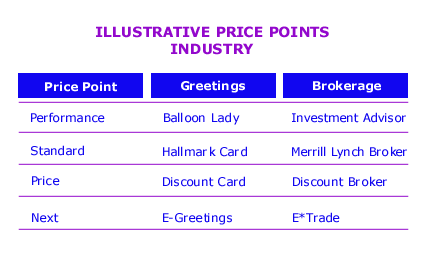BASIC STRATEGY GUIDE: STEP 15
Activity Two (Steps 13-18):
Develop new products and services to gain share with Core Customer segments.
Step 15: Evaluate the Company’s success in penetrating each Price Point in the market.

What:
Determine whether the Company needs one or more new PricePoints to match competitors serving core customers. In making this determination the Company should determine its current penetration of each Price Point in the market and evaluate the cost of providing these to core customers.
An industry may see up to four separate Price Points:
-
The Standard Leader is the product with the largest sales volume in the industry.
-
At the high end of the industry, Price Points are Performance Leader products, whose prices begin about 7% over the Standard Leader product.
-
Price Leader products strip benefits for all customers in return for very low prices.
-
Next Leader products strip some benefits of the Standard Leader product but then add other benefits that the Standard Leader product does not have. Usually Next Leaders also offer very low pricing.
Just as there are four product Price Point types in the market, so there can be up to four company types. The four company types have the same names as the product Price Points, as they specialize in the production and sale of one of these Price Points.
Why:
As an industry develops, product Price Points may vary in their growth rates and relative profitabilities. The Company must offer all Price Points that core customers would like to buy. The Company must offer any Price Point that might increase share with core customer segments in the market place, or it risks “failing” its target customer segments. The Company may not ignore, or even withdraw from, Price Points that its target customers continue to purchase. If it should not offer one of these price points, it opens up some or all of its customer relationships to other competitors in the market.
In addition to the avoidance of “failures” with customers, some product innovations in the next Basic Strategy Guide steps may require new Price Points. These innovations have unit costs and benefits that are quite different from those Price Points already on the market. Accordingly, the Company would normally establish separate Price Points for any innovation whose total costs per unit of product is different by 10% or more compared to another Price Point in the market.
What to Watch For:
-
A company must participate in any Price Point that is growing with its target customers. Failure to offer target Core customers the Price Points they need opens the customers’ relationships to failure and loss of volume another supplier.
-
The company must be careful of Price Point bias:
-
Marketing and sales-driven companies often dislike Price Leader products because they believe they harm the company’s brand image.
-
Operations or manufacturing-driven companies often dislike Performance Leader products because they slow operations and reduce operational efficiency.
-
-
In most markets, but especially in Hostile markets, the addition of Performance Leader products increases margins. They may also use more of the industry’s excess capacity than do the lower Price Points, speeding the end of Hostility.
-
Price Leader companies introduce Price Leader products when Standard Leader companies leave the Price Point uncovered or covered poorly.
-
Next Leader products and companies, if they begin to succeed, force significant changes in the way the industry operates. Often, they create a new industry.
-
Standard Leaders eventually cover most Price Points, putting pressure on Price Leaders and Performance Leaders.
Action:
Ensure that the Company offers good products at each Price Point that its core customers purchase. Develop new Price Points where the Company may offer a core customer segment an attractive value proposition.
More Information about Four Price Points on the Advanced Site >>
More Information about Price Point Bias on the Advanced Site >>
For helpful context on this step:
Videos:
-
Video #23: Full Explanation of Price Points and Competitor Types in a Market
-
Video #69: Overview of Products and Services Part 1: How to Look
Perspectives:
Symptoms and Implications:
